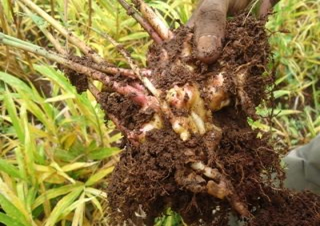Ginger
Pests and Diseases
A. WEED Control
The field should be kept weed free as one way of controlling pest and diseases.
B. INSECT PEST CONTROL
1. Shoot borer
The larvae bore into the shoots and plants wilts and die. The pest can be controlled by spraying carbaryl or dimethoate.


The picture above shows the Nematode
C. DISEASE CONTROL
1. Soft rot

The picture shows how ginger wuth soft rot loos
The leaves turn yellow and dry up. The shoots fall and cease to produce rhizomes. The inner tissue of the rhizomes turns soft, black and purifying mass.
Control is by plant sanitation. It is important to select a well-drained site, practice crop rotation and use only healthy rhizomes for seed which should be treated with a fungicide.
2. Rhizome rot
The figures below shows how ginger with rhizome rot looks

The disease causes severe rhizome rot and pseudostem collapse, sometimes it causes a brown streaking of the vascular tissue of the rhizomes and pseudostem. The disease spreads rapidly in the field with wet weather. The disease can be controlled by avoiding mechanical injury to the rhizomes when weeding and while carrying out other agronomic practices.
3. Bacterial Wilt

The picture shows the Bacterial wilt disease
The first symptoms are yellowing and wilting of the lower leaves which quickly spread upwards. In advanced stages the base of the pseudostem becomes water-soaked, readily breaking away from the rhizomes. The vascular tissues become dark brown or black. If the pseudostem and rhizome are cut, they give a white, milky exudate. The disease can be controlled by crop rotation.
D. NEMATODE CONTROL
The first symptoms are yellowing and wilting of the lower leaves which quickly spread upwards. In advanced stages the base of the pseudostem becomes water-soaked, readily breaking away from the rhizomes. The vascular tissues become dark brown or black. If the pseudostem and rhizome are cut, they give a white, milky exudate. The disease can be controlled by crop rotation.

the picture shows Ginger attacked with the Nematode.
